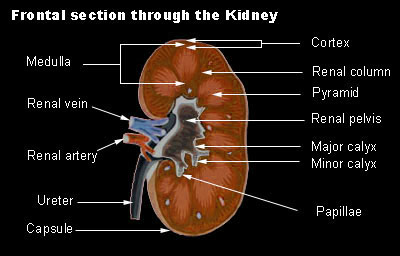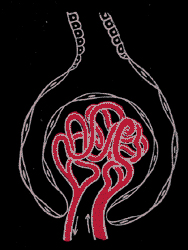Function of the Kidney
The kidney is involved in several things, in addition to urine production.
Erythropoietin is produced in the kidney. Vitamin D is modified in the kidney,
specifically, there is the addition of hydroxyl groups. The kidney plays an
important role in acid base balance. Renin is produced in the kidney.
Top of Page
Anatomy of the Kidney 
The kidney can be divided into an outer cortex and an inner medulla.
A kidney lobe consists of a medullary pyramid, its overlying cortex, and the
associated renal column.
The renal columns are the tissue in between the pyramids. A region where a
portion of the medulla project into the renal cortex are referred to as medullary
ray.
Large collecting tubules near the apex of the pyramid are the ducts of Bellini.
The ducts of Bellini are also called a papillary ducts.
Top of Page
Nephron
The functional unit of the kidney is the nephron. The nephron can be divided into
the glomerulus and uriniferous tubule. 
The capillary tuft of the nephron is referred to as the glomerulus. Bowman's
capsule is a double layered cap surrounding the glomerulus. This is the first
portion of the uriniferous tubule. The glomerulus and Bowman's capsule make up
the renal corpuscle.
Another term for the renal corpuscle is Malpighian corpuscle.
Bowman's capsule leads to the proximal convoluted tubule. The proximal
convoluted tubule leads to the loop of Henle. This then leads to the distal
convoluted tubule. The distal convoluted tubule then leads to the collecting duct.
The inner layer of Bowman's capsule is the visceral layer. It consists of cells
called podocytes. The outer layer of Bowman's capsule is the parietal layer.
Pedicels are the foot processes on the podocytes. 
Histology hint from Sarah Bellham: The Latin prefix pedalis, pes and pedis
refers to the foot. Such words include pedal, pedicure, pedestrian, and pedicels.
Top of Page
Juxtaglomerular Apparatus
The juxtaglomerular cells secrete renin. The macula densa are specialized cells
in the distal convoluted tubule that are sensitive to sodium. The juxtaglomerular
cells and macula densa make up the juxtaglomerular apparatus.
Top of Page
Blood Supply
The afferent arteriole branches off the interlobular artery. The afferent arteriole
supplies blood to the glomerulus. The glomerulus is a capillary tuft. The
glomerular capillaries converge to form the efferent arteriole. The peritubular
capillaries is a second capillary network which arise after the efferent arteriole.
They surround the proximal tubule, loop of Henle, and distal tubule. Vasa recta
are the "straight vessels" which arise from some of the efferent arterioles.
Top of Page
Source:
Histology: A Text and Atlas
Michael H. Ross/Edward J. Reith
|